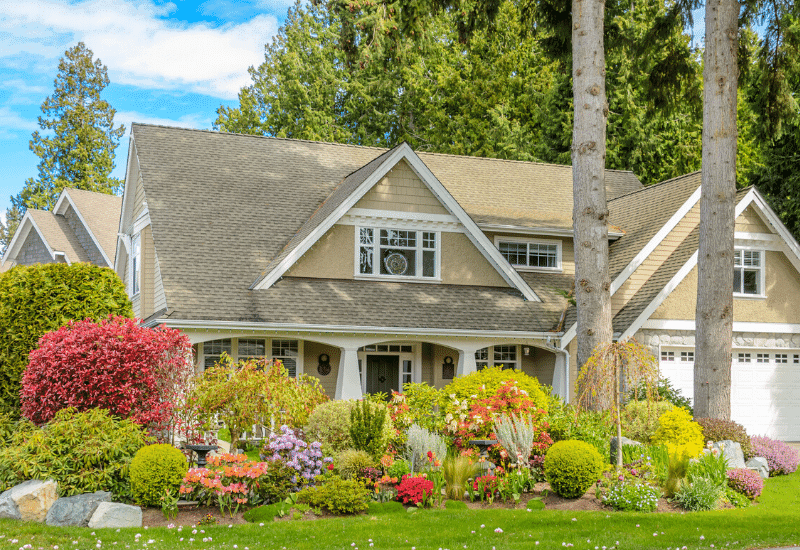
A beautifully landscaped front yard with flower beds and borders and well chosen shrubs gives a great the first impression to visitors and passers by or walk up to your front door.
In addition to elegantly frame a house and anchor it to the site, the best shrubs for front of the house will can provide privacy, act as sound insulation and boost your home’s curb appeal for a more welcoming appearance.
In many cases, front yards are mainly foundation planting, with well shaped and colorful varieties that soften the hard hedges of buildings, embellish pathways and frame windows, doors and porches, like hydrangea, roses and junipers.
Several criteria come into play when it comes to choosing the bushes to plant near your house. Indeed, your selection should reflect your tastes and match the style of your homes, but don’t forget to check shrub’s size at maturity, along with other growing conditions like the nature of the soil, the climate of your region and the amount of sun and shade on your plot.
Low-growing evergreen and flowering shrubs are very popular for foundation planting along the front of the house, as are species with high sculptural value; rambling bushes and those with an unkempt look are less popular, though they will suit very informal styles like cottage gardens.
For a great, harmonic and eye catching landscaping effect, with colors, shade and light and even scents, you will need to grow and balance a range of flowering, evergreen and formal shrub varieties.
Here you can find out which ornamental shrubs for the front of the house you can use to visually enrich your entranceway all year round.
Each has real value for the green space in front of your house, but first let’s make sure you know how to use them like a professional.
How To Choose Shrubs For Foundation Plantings
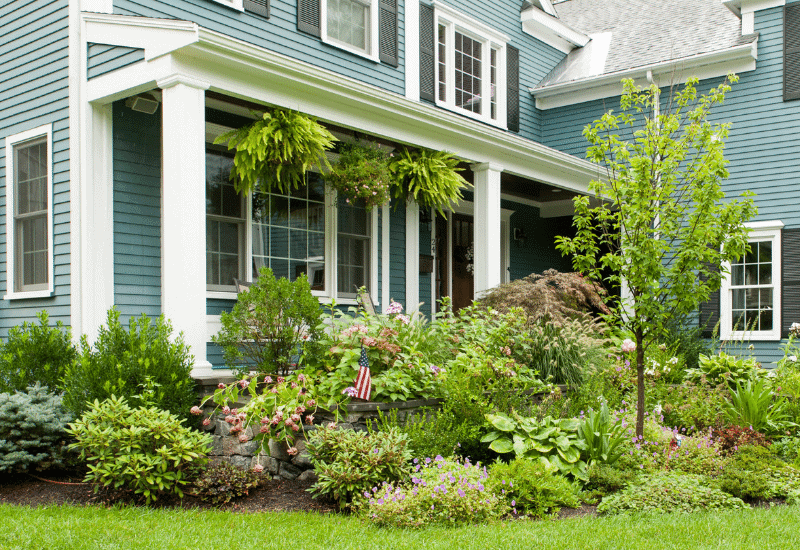
Your front garden has special qualities, so you need shrubs that match them. In your back yard, you can be more relaxed, and you will want areas for activities, entertaining, a shed, even a vegetable garden. But you want a “picture perfect” landscape outside your main door.
We also spend more money and time for borders, beds and shrubs when they are at the front of our homes; the choice is often for higher maintenance plants, with more showy blooms and with more defined shapes.
Let’s go through these points step by step.
Foundation Planting In Your Front Garden
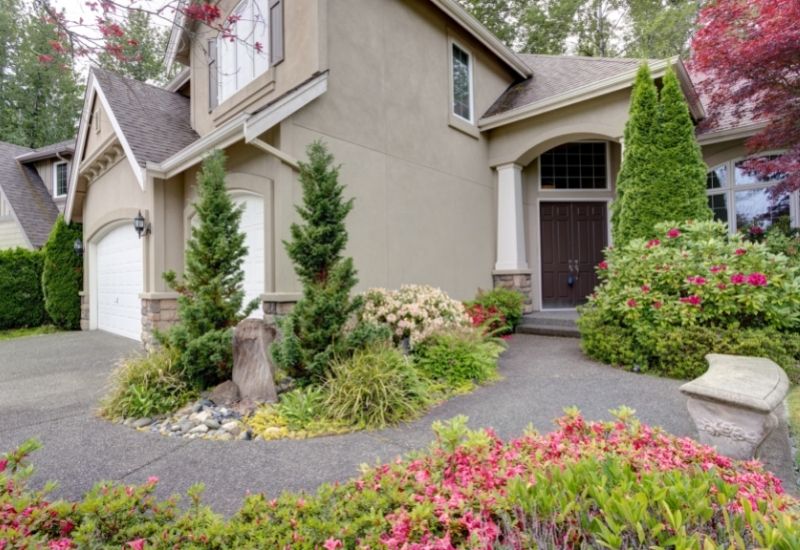
Foundation planting is an essential part of front gardens. It is planting of beds, and borders near the walls of your home. And shrubs have an essential role in it.
In many cases, front yards are so small that all you end up having is just this: a bed or border that screens and softens your main entrance and front windows…
If you want to be successful with foundation planting you need to:
But it’s not enough to understand foundation planting for a stunning front garden, let’s talk about it…
How To Use Shrubs In Your Front Garden
Foundation planting is key for the area just next your your house, but there is often more in a front garden. For example…
And finally, it all depends on your design.
Use Shrubs To Match Your House And Front Garden Design
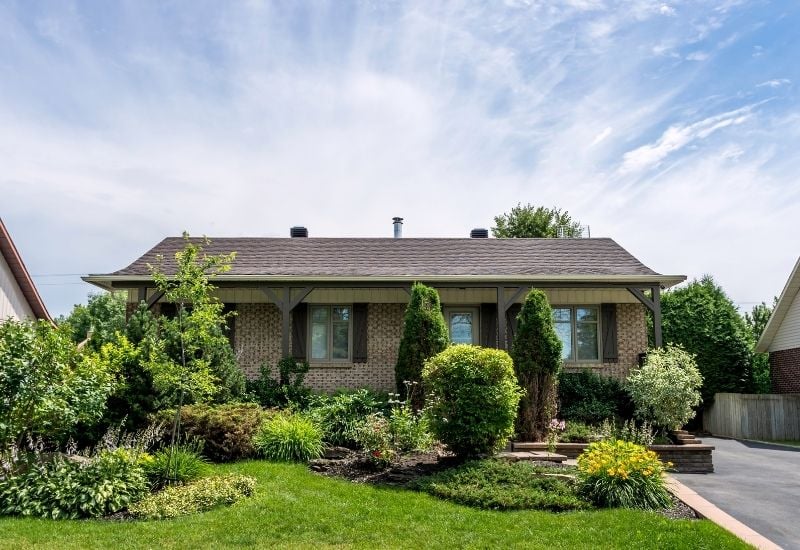
All front gardens are different, so you need to choose the right shrubs for the theme and design you like… This should follow at least two lines.
Talking about which, here they are!
16 Easy, Breezy, Beautiful Shrubs For Front of House Landscaping
While evergreens shrubs give a foundation planting year-round structure, but incorporating deciduous shrubs that feature striking texture or colorful bloom add visual interest to your plantings all year long.
Choose plants with a long blooming season to provide continuous color from late spring or early summer through late summer or early fall and of great appeal in other seasons too, with stunning fall foliage, attractive berries in winter, or lush summer foliage.
These low-maintenance foundation shrubs for the front of your house will enhance your home’s entry for an inviting first impression.
Flowering Shrubs For Your Front Garden
Having flowers blossoming in front of your house is everybody’s dream, and you want very beautiful and eye catching ones; so, we looked for the best ones for you!
1: Reblooming Shrub Rose (Rosa spp
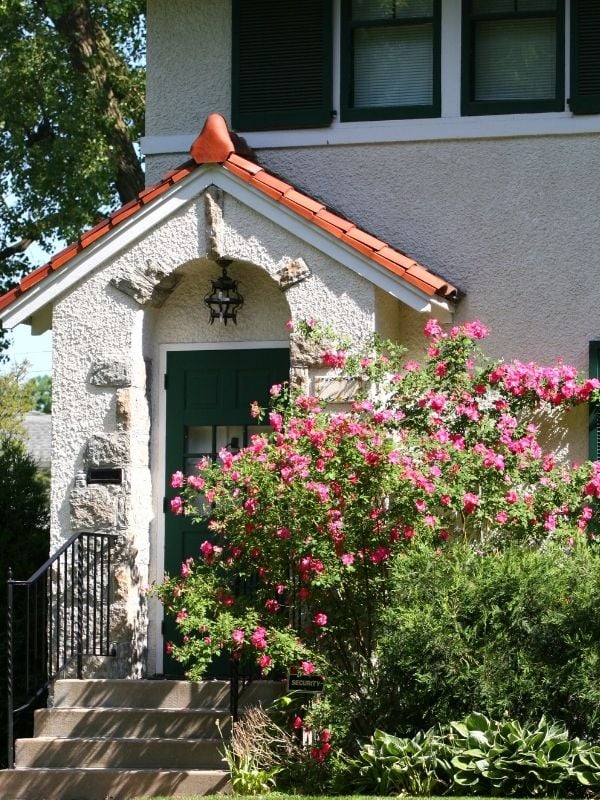
Shrub roses are ideal for front gardens in foundation planting but also in hedges; you can even have a full rose garden outside your door if you have enough space.
But you don’t want tall and rambling varieties. So, your best choice are English shrub roses, hybrid tea roses and some small floribunda varieties (that usually grow to about 5 feet tall, or 1.5 meters).
These are often also reblooming varieties, which start in late spring and keep flowering till fall, sometimes even frost. This way, you will have colors and even intoxicating fragrance throughout the season.
However, roses need a lot of care and a ventilated and sunny place. For this reason they are ideal for most informal garden designs but only if your front yard is well lit and open; if you have overshadowing trees and you live in a pace with stagnant air, you may have to renounce their beauty.
2: Hydrangea (Hydrangea spp.)
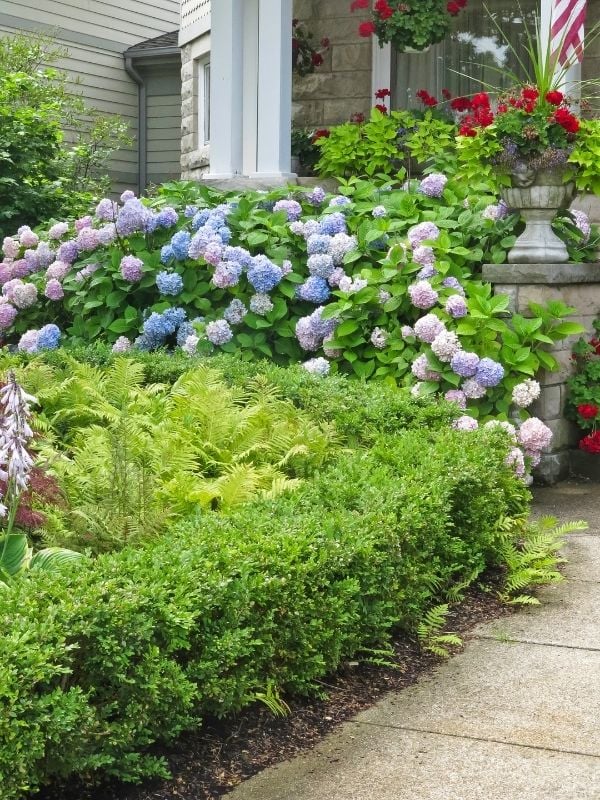
For a front garden in partial shade one of the best shrubs is hydrangea; its large and showy blooms are famous for their range of pastel colors from white to violet purple and generous displays.
But there are also varieties with stronger shades, like deep blues, purples and reds. Some varieties can grow tall, but others are perfect to have under windows.
The foliage is lush and green, and it gives a sense of freshness and vitality from spring to fall. They have a naturally round habit, but they also have a very herbaceous and informal look.
Hydrangeas look great in the dappled shade of trees but you can grow them in sunnier gardens as well. They will suit any temperate looking design, from urban to English country and cottage gardens, as long as you want a natural effect and a traditional looking garden.
3: Azalea and Rhododendron (Rhododendron spp.)
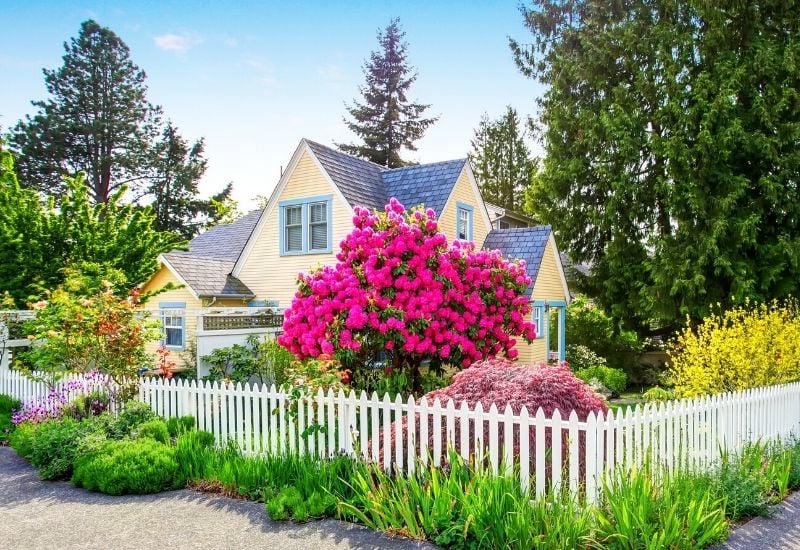
For spectacular blooms in your front of your house, consider some small varieties of azaleas and rhododendrons. They will give spectacular blooms that cover all the plants in spring, and some are also very fragrant.
The purity and vibrancy of their colors is world famous, from white to purple, with reds, yellows, oranges, violets and pinks in between.
They offer a double effect to passers by: the overall naw dropping effect of the blossom and then the elegant and slightly exotic beauty of each individual flower.
The dense and finely textured dark foliage that covers the plants till fall or beyond is a guarantee of structure and green for front yards. On this note, most rhododendrons are evergreen, while most azaleas are deciduous.
Azaleas and rhododendrons are ideal for foundation planting, borders and on the sides of paths in English country, cottage and other natural looking informal styles;
but in a well kept gravel or courtyard garden they can be a surprising presence. Finally, they are ideal for Japanese and oriental designs too, but not for tropical, dry, coastal or Mediterranean gardens.
4: English Lavender (Lavandula angustifolia)
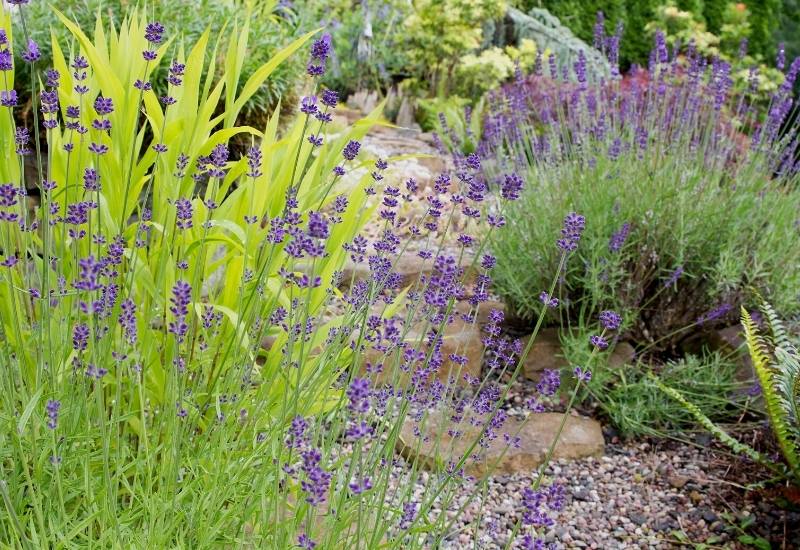
English lavender is the sun-loving flowering shrub perfect for your front yard’s sunny areas; you can use it for foundation planting, for borders and at the sides of paths as well.
Unlike other lavender varieties, it is medium sized, it has a much more perfume like scent (as opposed to soap) and it is hardier, thus suitable to more temperate climates.
It has abundant, long lasting and sometimes repeated blooms of shades of white, pink, lavender and violet and it is a real magnet for pollinators. The fine and elegant foliage will then keep you company for the rest of the year!
English lavender looks magnificent in Mediterranean, dry and coastal gardens as well as Hispanic and Islamic ones, but in all honesty it will fit in perfectly in gravel, urban, cottage and English gardens as well.
5: Rosemary (Rosmarinus officinalis)
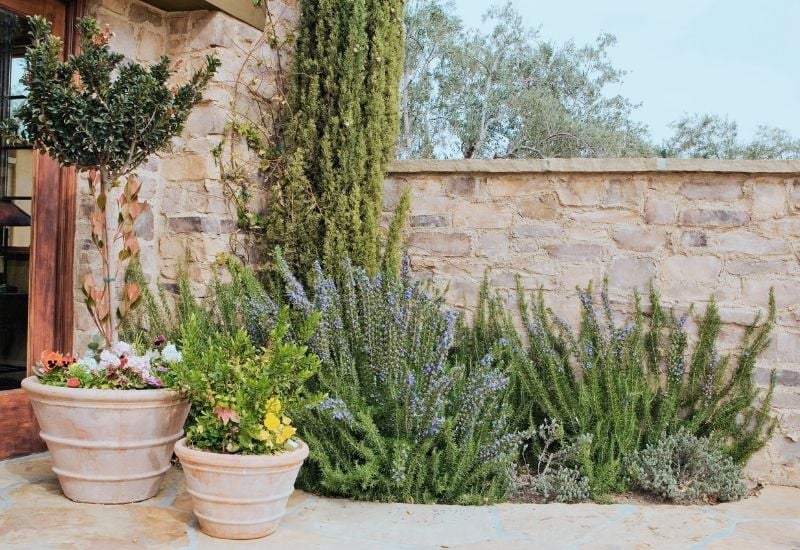
Rosemary has many advantages as a front garden shrub; to start with it cuts down on maintenance and watering; next, it has beautiful blooms in winter; what is more, it repels mosquitoes and flies; finally, you can use it to cook!
The flowers are plenty and lilac in color, and they will liven up your yard when you most need it.
The aromatic foliage is dense and finely textured at the same time, and it is also evergreen. There are upright or even creeping varieties (Rosmarinus officnalis prostratus). All are strong, resilient and energetic; they are also very easy to prune and keep in shape.
Rosemary will work well for foundation planting and on pathway sides in all informal garden designs and styles, but it is a must in Mediterranean, coastal and Hispanic gardens. It will also be a striking shrub in gravel gardens and it is very suitable for containers, if you live in a colder region.
6: Rose Mallow (Hibiscus moscheutos)
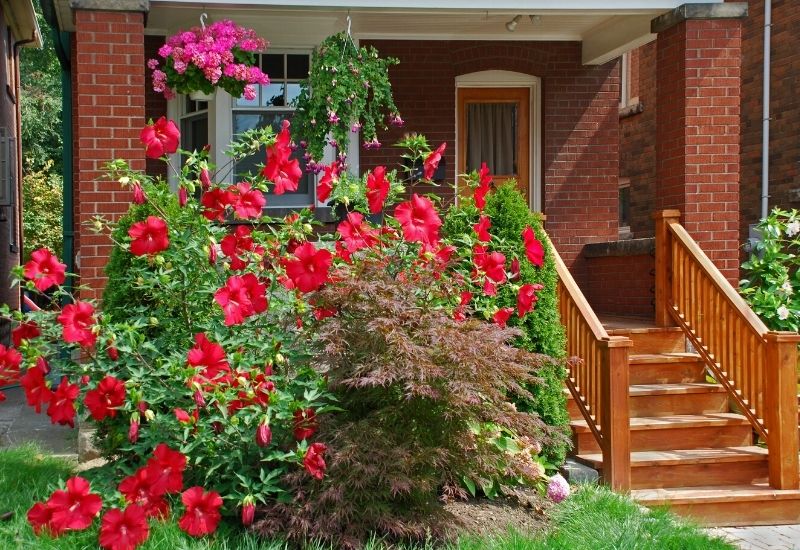
For a shrub with large, showy and colorful flowers to grow in your front garden, swamp hibiscus is a great option. Its blooms can be from 5 to 12 inches across (12 to 30 cm!) and they come in shades from white to purple, with large paper like petals and their iconic dark purple center with golden stamen.
There are many colors, from white to purple. For a delicate look, ‘Ballet Slippers’, white with light pin magenta shades is just extraordinary.
The foliage is usually mid green and very lush, but there are varieties with purple leaves too, all perfect for privacy and for hedges as well.
Hibiscus is one of the few cold hardy shrubs that can work in virtually all front garden designs; it works well in exotic styles thanks to its round blooms, but it also suits temperate looking yards, thanks to its herbaceous foliage.
Finally, you can even train it into a small tree and give it a geometric shape, which would look good even in formal settings.
7: Rock Rose (Cistus spp.)
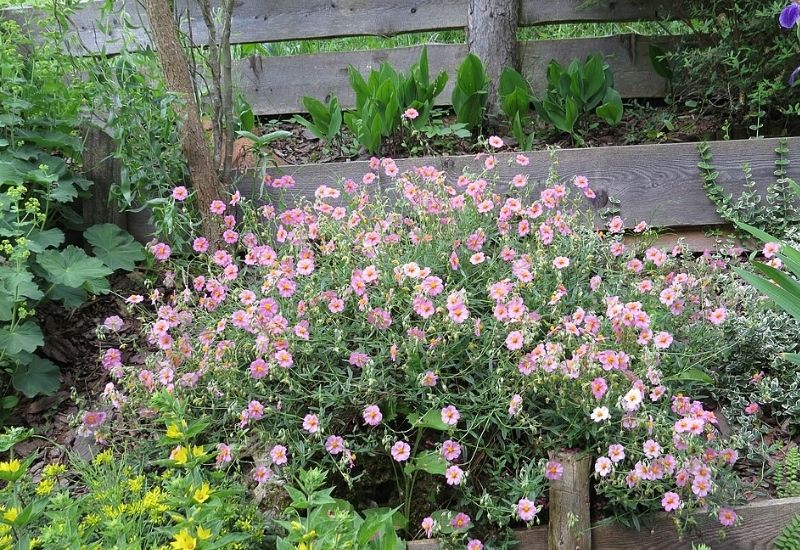
Rock rose is a fast-growing evergreen shrub ideal shrub for a natural looking, traditional front garden that wants to bring a bit of countryside around your hone but also aims at showy blooms.
The round blooms have a paper texture, and they are famous for their lemon and gold yellow centers, purple spots and large blooms, 3 to 4 inches wide (8 to 10 cm).
They can be white, pink, or magenta, and they come profusely on the thick foliage of this bush with a round habit.
This makes it good for hedges, borders and foundation planting, and the herbaceous foliage has the advantage of being evergreen, giving you structure and privacy all year round.
Rock rose is good for most temperate and informal front garden designs, from English country to urban, but it is also great for coastal, Mediterranean and gravel gardens. It will give you long late blooms with very little work, because it is low maintenance!
8: Bottlebrush (Callistemon spp.)
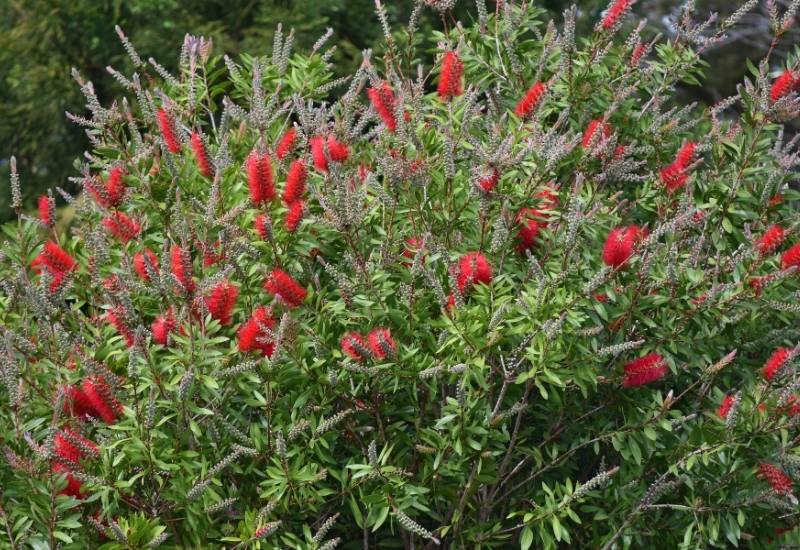
For an elegant show stopping shrub to grow in your front garden in hot countries bottlebrush is really priceless. This frost tolerant and woody shrub is a marathon bloomer, in fact it will keep going all through the year, though at different rates.
The flowers are very original as well, as they look like brightly colored bottle brushes at the end of the branches, in white, pink or red, and 6 to 10 inches long (15 to 25 cm)!
Some varieties have spikes that pint out, others have a softer nodding habit. It has a very exotic look complemented by the glossy, evergreen and hard elliptical green leaves, which give off a pleasant lemon fragrance when you rub them.
The bush is dense and round shaped, easy to train into a tree too. A very elegant and unusual plant indeed.
Bottlebrush is perfect for warm climate front gardens; it is amazing in gravel gardens, Mediterranean designs and city gardens; and if you have a formal style yard, this is a good option, especially if you train it into a small tree and / or grow it in a container.
Evergreen Shrubs For Your Front Garden
A good front garden is green all year round, and this is why you will need some evergreen shrubs. They will provide life and structure during the cold months, and a sense of continuity throughout the seasons.
Some are also slow growing as well, many are low maintenance and we have already seen some blooming varieties. Now it’s time to look at those that are mainly prized for their foliage.
9: Bay Laurel (Laurus nobilis)

Bay laurel will give you thick and glossy foliage all year round, providing privacy, structure and a favorite nesting place for birds.
It is a slow growing shrub with excellent qualities, not least its culinary and medicinal use. It is low maintenance and generous, but it needs a dry climate, or it may develop parasitic ailments.
It is also easy to prune and even shape to taste. In spring, it will brighten up with many small yellow flowers, not showy, but still interesting; these will become purple black berries on female plants for an extra touch of color later in the season.
It is also a long lived bush, so you can enjoy it for many decades and you do not need to replace it.
We associate bay laurel with Mediterranean gardens but it is suitable to most styles, and in particular, you can grow it in a formal setting, because it can be trimmed into any shape, in fact it is even perfect for the most formal art of all, mazes and topiaries!
10: ‘Stricta’ Chinese Juniper (Juniperus chinensis ‘Stricta’)
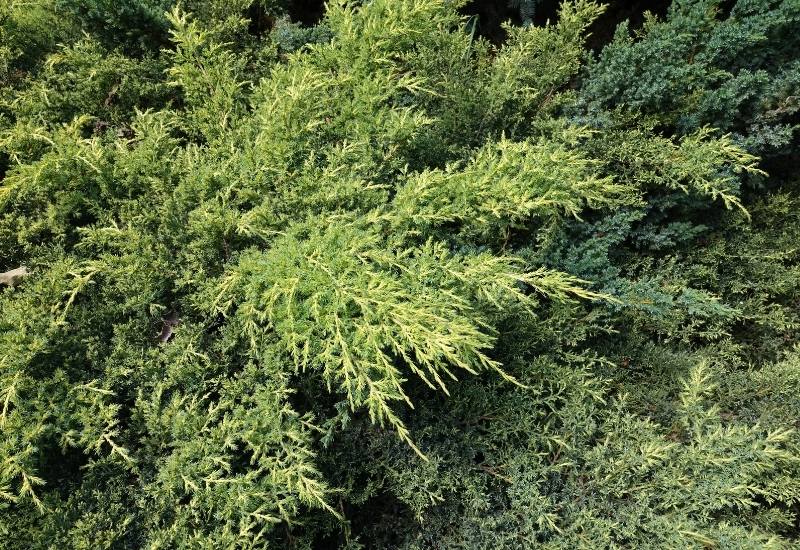
Juniper shrubs are ideal evergreens for front gardens, and we picked one with very unique qualities, the cultivar ‘Stricta’. It will bring its dense aquamarine foliage to the front of your house, with its very fine filigree like texture all year round.
This way you can add color and interest. The branches are fully covered by the leaves, but they still produce upward lines, which make it ideal for a vertical accent.
Finally, it has a natural pyramidal shape, and this can really lift up any yard, whether you grow it as foundation planting or to decorate your main door pathway…
‘Stricta’ Chinese juniper will suit all informal designs and styles, and it is excellent for courtyard, urban, gravel and suburban gardens.
If you like the idea but you want a different color and shape, there are many varieties you can grow, like the green columnar ‘Spartan’.
11: ‘Red Robin’ Photinia (Photinia x fraseri ‘Red Robin’)
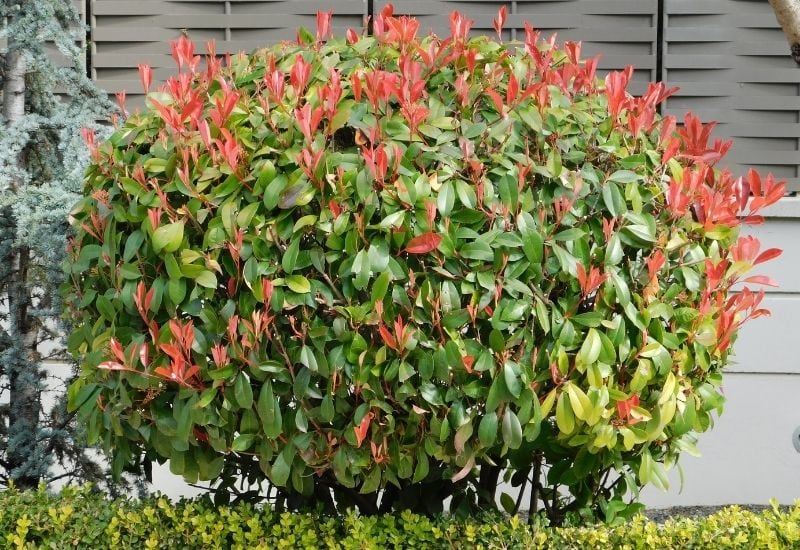
‘Red Robin’ photinia is a low-growing evergreen shrub to lighten up your front garden with warm passionate color displays.
It is exceptional because the older green and glossy leaves are topped with deep ruby red and shiny younger ones.
These can even cover the whole of the plant at some stages, giving you an extraordinary effect. The foliage is dense and oval in shape, and very tolerant to pruning.
What is more, it will cover in a blanket of white flowers in spring, and these will turn into bright red berries later in the season.
‘Red Robin’ photinia is a very adaptable shrub for front gardens; because it is easy to trim, you can turn it into square and geometric hedges, so, even if your garden is formal, it will work well. But it is good also for all temperate looking informal designs and Japanese gardens too.
12: ‘Ferox Argentea’ English Holly (Ilex aquifolium ‘Ferox Argentea’)
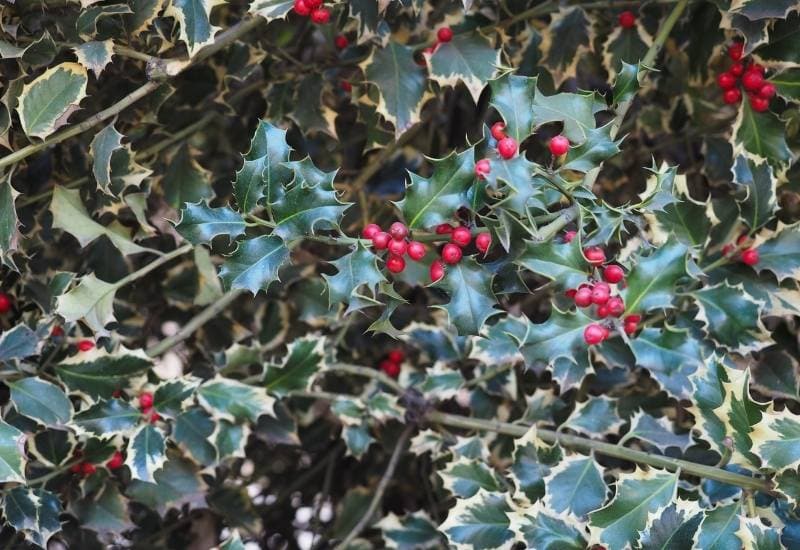
As an evergreen shrub, English holly ‘Ferox Argentea’ is a real asset for a front garden. It has very glossy, spiked leaves and they are deep dark green in the middle with beautiful butter cream edges.
The effect is very striking, producing a very intricate show of light and colors. These come on purple branches, and the plant has a dense habit, perfect for privacy.
You will see many white flowers opening in spring, small but in large numbers. These will give way to a profusion of berries that will turn bright red by fall and they will stay on in winter.
You can also use it for striking Christmas decorations too. It is a winner of the Award of Garden Merit by the Royal Horticultural Society.
‘Ferox Argentea’ English holly is a slow growing shrub, but it can become quite big; however it is tolerant to pruning, and you can keep it fairly small too. It will suit informal designs with a temperate theme, both urban and naturalistic.
13: Spotted Laurel (Aucuba japonica ‘Picturata’)
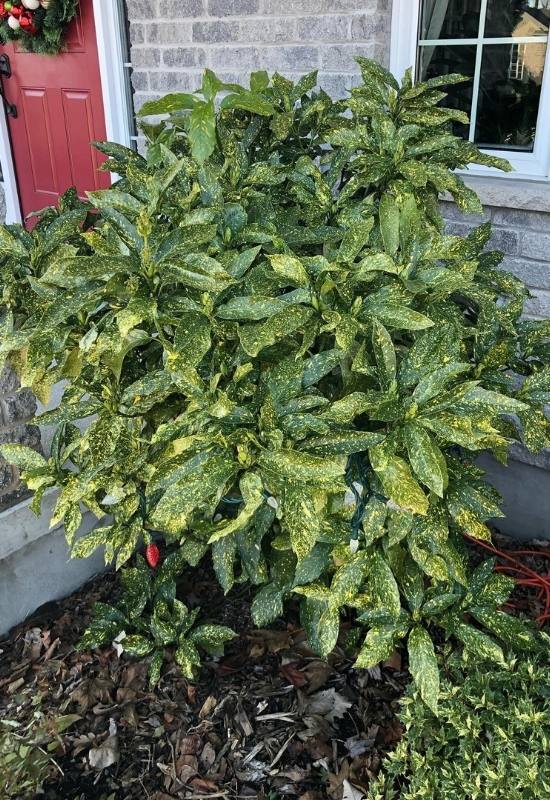
Spotted laurel is an evergreen shrub you can grow in your front garden to add color and interest all year round. It has broad, elliptical and pointed leaves that have a bright mustard yellow center and very dark green edges, with tiny yellow spots in them as well.
Add to this that the foliage is extremely waxy and leathery, giving you a very strong effect indeed. Then again, it is also very dense, so it can give your yard a lush and florid appearance.
But this is not all… In spring you will also enjoy its purple flowers with white pistils to give you even more vibrancy.
Once the blooms are spent and pollinators have done their job, spotted laurel will start producing round and shiny red berries which ripen slowly and sometimes stay on till the next blossom, throughout the whole winter season and into the early months of spring!
Spotted laurel is a low maintenance plant which offers a perfect solution for foundation planting, even small ones, thanks to its vibrant colors, vitality and continuously changing display.
Finally, it is also ideal for shady gardens as well… Grow it in hedges, as foundation planting or even in containers and it will not disappoint you!
Shrubs For Formal Front Gardens
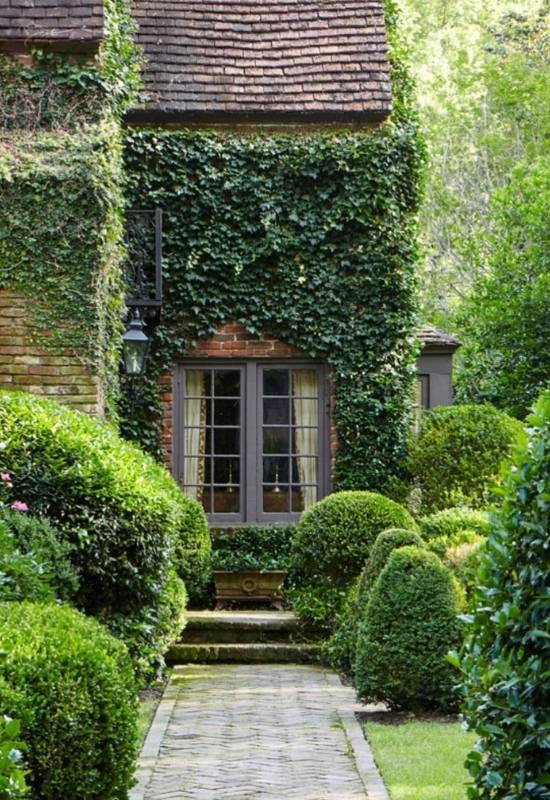
Some of the shrubs we have seen so far can adapt to formal garden designs, but now we will see the very best ones, those you can turn into square hedges and topiaries, to give you a helping hand in your choice given the fairly small range of plants suitable to this type of green spaces.
14: Boxwood (Boxus sempervirens)
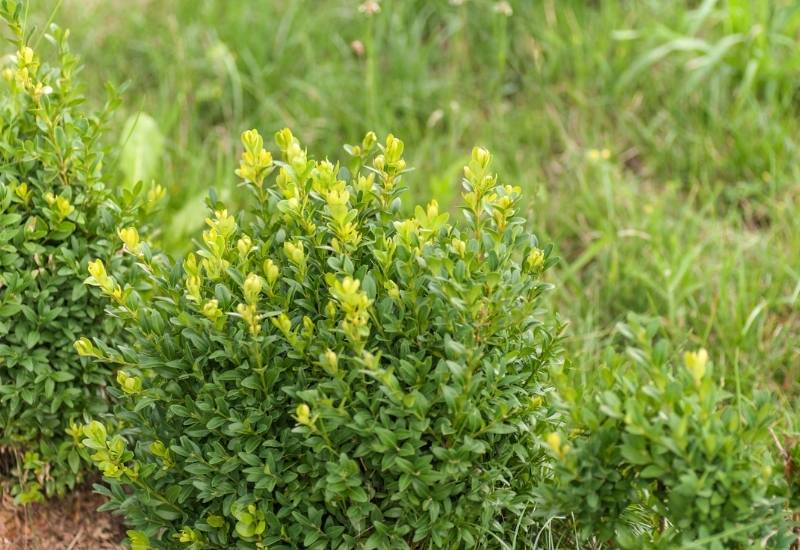
Boxwood is a classic evergreen shrub of formal gardens, and if your front yard needs a suitable plant, this is it! It is an evergreen bush with super dense foliage of in mid green shades and made up of many small oval leaves.
These totally hide the branches, forming an impenetrable “wall”. For this reason, it is excellent for privacy. But it also excellent to cut into any shape; in fact it is the world’s favorite plant for topiaries.
And this means that you can also use it for foundation planting or to shape natural statues to accompany your paths or even to frame beds.
It will also bloom in spring, with beautiful but inconspicuous white flowers, followed by tiny fruits that look like capsules.
Boxwood is perfect for formal designs, because it can take in any shape you like. It will need lots of maintenance if you want it to keep it, which means trimming at least three times a year.
The first pruning should aim to thicken the branches, which will give you a very thick blanket of leaves with no gaps. Also remember to water it abundantly until it establish itself.
15: Anglo Japanese Yew (Taxus x media ‘Hicksii’)
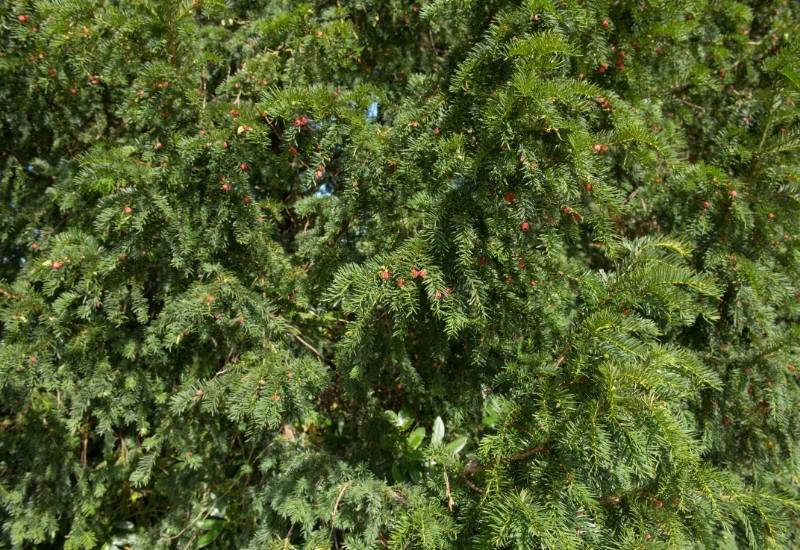
Anglo Japanese yew is an semi-dwarf, evergreen conifer shrub that you can shape into the geometric shapes that you need in a formal garden.
Hybrid between English and Japanese yew, Anglo-Japanese yew is a popular hedge plant, and like boxwood, you can also make it into sculptural shapes and even green statues if you have the skills, or a professional gardener.
The foliage is very finely textured, with soft needles, and it fully covers the branches, though if you are not careful, you may have small gaps.
It is a high maintenance bush but worth it. What is more, it will produce small but attractive red cones that add a twist to the color pattern of this popular bush.
Anglo Japanese yew is perfect for formal gardens, but it also has great qualities for informal ones, because you can let it grow naturally and it still looks very attractive.
It can grow into a big plant, but it is easy to prune to size. Like with boxwood, early pruning should aim to thicken the branches. The only drawback of this conifer is that all parts are toxic if you ingest them.
16: Inkberry (Ilex glabra ‘Shamrock’)
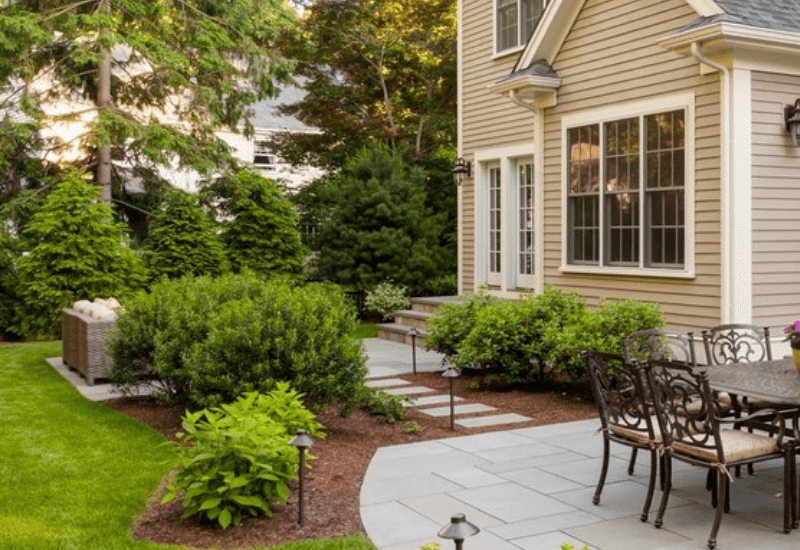
Inkberry is a favorite evergreen for front gardens because it propagates fast with stolons, and it has healthy, dark green foliage.
Ilex glabra, commonly called inkberry or gallberry, is a slow-growing, evergreen shrub with very fine texture, and a lovely round habit. For this reason, they will also suit formal designs, while costing little in terms of time and money.
This little beauty will also give you a profusion of small greenish white little flowers that last for months, in fact they will appear in late spring and keep coming till the end of summer!
These will then become a multitude of very dark blue, almost black berries that will cover it from fall well into the winter months.
Naturally, this will enliven your garden with birds that come to peck on them, keeping your winter garden attractive and interesting.
You can use inkberry for foundation planting, mixing it with other shrubs and perennials, but you can also grow it in isolation, and exploit its spherical shape, maybe next to columnar, conical or pyramidal shrubs or small trees.
Because it is small, it is also great for modest sized front gardens, and if you grow it in containers, you can make the best of its natural shape, especially if you use decorative round pots.
A Beautiful Front Garden With Shrubs
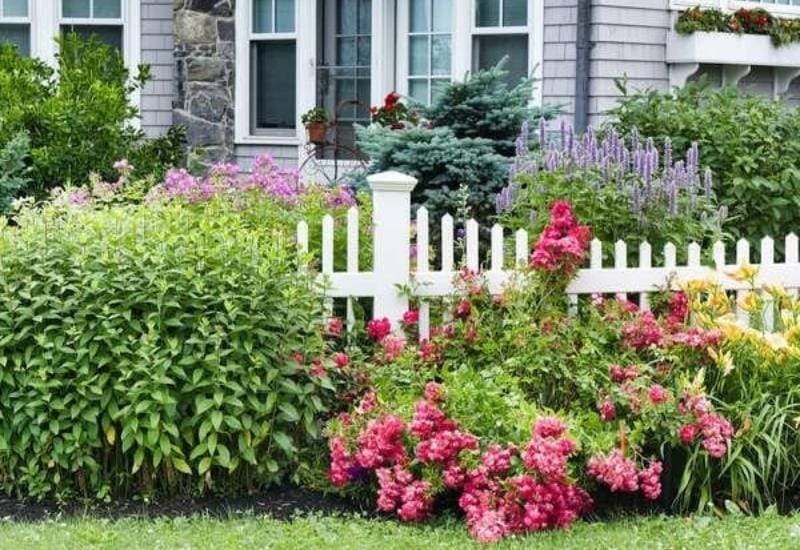
Pick and choose the shrubs that best suit your needs from the ones in our list.
There are also others, even similar to these, but I am sure you have got a very good idea of what you can grow and how you can give a sense of unity, harmony and overall design to your front garden.
Do it wisely and your front yard will be the envy of all the neighborhood!

Written By
Amber Noyes
Amber Noyes was born and raised in a suburban California town, San Mateo. She holds a master’s degree in horticulture from the University of California as well as a BS in Biology from the University of San Francisco. With experience working on an organic farm, water conservation research, farmers’ markets, and plant nursery, she understands what makes plants thrive and how we can better understand the connection between microclimate and plant health. When she’s not on the land, Amber loves informing people of new ideas/things related to gardening, especially organic gardening, houseplants, and growing plants in a small space.
